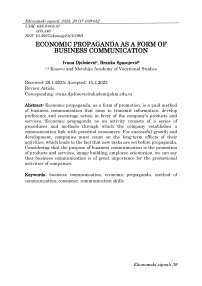Economic propaganda as a form of business communication
Автор: Djelošević I., Spasojević B.
Журнал: Ekonomski signali @esignali
Статья в выпуске: 1 vol.20, 2025 года.
Бесплатный доступ
Economic propaganda, as a form of promotion, is a paid method of business communication that aims to transmit information, develop preference and encourage action in favor of the company's products and services. Economic propaganda as an activity consists of a series of procedures and methods through which the company establishes a communication link with potential consumers. For successful growth and development, companies must count on the long-term effects of their activities, which leads to the fact that new tasks are set before propaganda. Considering that the purpose of business communication is the promotion of products and services, image building, employee orientation, we can say that business communication is of great importance for the promotional activities of companies.
Business communication, economic propaganda, method of communication, consumer, communication skills
Короткий адрес: https://sciup.org/170209520
IDR: 170209520 | УДК: 658.8:005.57; 005.346 | DOI: 10.5937/ekonsig2501039D
Текст научной статьи Economic propaganda as a form of business communication
Business communication is the exchange of information between people inside and outside a social organization. It involves the commercial benefit of the organization and means the giving and receiving of business information in order to achieve certain business goals and specific results. Business communication is of utmost importance in customer and consumer relations, public advertising and marketing, public relations, corporate communications, community engagement, management reputation, interpersonal communication, employee engagement. The importance of business communication in an organization is great because it can be crucial in achieving success, or failure, of the organization itsel (Zolak, 2024; Ći-tić, 2017). Business communication is a very important part of business, organization, and management system. Transmitting messages, conducting correspondence, exchanging and processing information, issuing and receiving orders between structures in the organization, contacts with business partners, economic propaganda - all of this constitutes an integral part of communication, without which an organization would not be able to operate. Successful business communication is essential for managers, since they are the ones who inform the organization about strategies, communicate with the public and business partners, give orders, and more (Pe-rić, et al., 2014; Marković, Rado-šević,2014). When choosing a communication medium, it is important to consider who we are sending the message to, as well as the essence and goal of the message itself. Business communication involves the use of certain media: the Internet, the press, radio, television and personal communication.
The concept and importance of economic propaganda as a form of business communication
The word propaganda itself comes from the Latin word propagatio, which means spreading. This promotional instrument has numerous synonyms, such as: economic propaganda, advertising, promotion, propaganda, commercial propaganda. Recently, the term "advertising" has increasingly been used for this concept. Commercial, i.e. economic propaganda is a paid form of communication and is widely used in the business approach (Mihic, et al., 2023; Durlević, et al., 2024; Mihić, 2024).
One of the generally accepted definitions of economic propaganda is: "propaganda is a massively paid form of communication, the ultimate goal of which is to inform, attract attention and encourage actions beneficial to the advertiser". "Propaganda is a deliberate, systematic attempt to shape perception, manipulate cognition and direct behavior in order to achieve the effect that the propagandist seeks." Therefore, propaganda is a method of promotion where the advertiser (company, non-profit and non-profit organizations) finances the presentation of information about itself and its products and services to existing and potential customers, through means of communication (Vuković, et al., 2024; Dašić, Jeličić, 2016; Dašić, 2018). Economic propaganda is the most important form of communication between a company and the market. It should: transmit information, develop a preference and encourage action in favor of the products and services of a particular company. On the other hand, it helps the company to retain loyal consumers, reduce the number of those who could switch to competitor products, and expand sales to new categories of customers. Economic propaganda allows the consumer to quickly find the products and services they need, make a choice according to their needs, be informed about the existence of new or improved existing products, contributes to consumer education, i.e. acquiring knowledge about products and services, and is also an effective means of changing lifestyle habits. The emphasis in economic propaganda is on the benefits of the product to consumers, which is why its features are often compared with existing products (Dašić, et al., 2022). Demonstration of the product leaves an impression on potential buyers. The message is more convincing if the manufacturer has an established reputation in the market. Commercial propaganda is aimed at the buying center. The business market is better segmented and it is easier to adapt the promotional message to individual segments.
Commercial propaganda is an instrument of the promotional mix by which the communicator informs, educates and achieves some profit. It is implemented on the basis of a previously defined plan, through a mix of media and resources, aiming to satisfy the principles of efficiency and effectiveness.
There are numerous participants involved in propaganda. "Here, first of all, we mean:
-
- advertisers,
-
- commercial propaganda agencies,
-
- media,
-
- consumers, - competitors, - government
An advertiser is any company that uses propaganda to promote its products and services in a specific market and a given segment of potential customers. It bears all costs and responsibility for any problems that may arise during the implementation of propaganda, and in turn is the beneficiary of the economic effects of propaganda.
Propaganda agencies refer to specialized organizations that provide services to advertisers in planning and implementing propaganda tasks, for which the advertiser is not qualified in terms of personnel and organization, or has no economic interest in performing these tasks in its own organization.
Media - transmitters, channels, intermediaries are different terms that imply the same essence, and represent such objects (persons) through which the transmission of a message to consumers, i.e. the target segment, is activated in various forms. The media make space, time, technical characteristics and established connections with the market available to advertisers, for a cer- tain financial compensation. The choice of media depends on the following conditions: advertising goals, target segments, product (service) characteristics and life cycle, general market situation, promotional activities, seasonal sales, sales rhythm, number and availability of media, quality, content, location and cost of media, etc.
Consumers are the recipients of advertising messages, regardless of whether they are existing or new. Advertising, as well as all other activities of advertisers, are directed towards them (Kovačević, Da-šić, 2022). The role and importance of this advertising element is determined by their number, income, level of education and social status. The price of advertising sometimes depends on these conditions.
Competitors as elements of advertising are important, because advertising is considered one of the sharpest instruments of competitive struggle for the market and customers.
"The government, or rather the state administration, is an important element of the propaganda system, because it has the role of creator of economic policy that defines the conditions and frameworks for the functioning of the economic system." All these actors taken together form a complex, intricate and dynamic activity that characterizes and shapes the market system of the country and shapes the market situation.
Forms of propaganda
The classification of propaganda actions can be carried out according to different criteria. Numerous classifications are given in the literature. The role of the sender of the message, i.e. the advertiser, is played by producers or marketing channels, which in modern business conditions often jointly initiate and finance a certain propaganda campaign (so-called joint or cooperative commercial propaganda). Advertisers can be both government and non-governmental organizations that often promote social goals and point to certain social problems. Depending on who is the recipient of the propaganda message (target audience), it is possible to speak of propaganda aimed at individual consumers and business buyers (producers, intermediaries). Different types of commercial propaganda can be differentiated based on the characteristics of the propaganda message: so-called informational, transformational, institutional, selective vs. generic message (a message aimed at promoting a specific brand or product category) and a message aimed at building goodwill or stimulating a specific action (purchase). Economic propaganda can be classified depending on the means used to broadcast propaganda messages (print media, electronic media, etc.).
In addition to the above, the following types of commercial propaganda can be mentioned:
Individual and joint propaganda -Depending on the number of entities participating in the creation and financing of propaganda, we distinguish between individual and joint propaganda. Individual propaganda is organized and financed by a single advertiser. A larger number of advertisers participate in joint propaganda. The problem with this type of propaganda is the method of financing, because it requires large financial resources, so this role is most often taken on by a producer association or some state institution.
Primary and selective propaganda -The focus of primary propaganda is the product, but not the producer, unlike selective propaganda, which promotes a specific product, but also a specific producer, or its product brand. Both can contain elements of other types of propaganda. Producer associations and other institutions play a significant role in financing primary propaganda, while selective propaganda is financed by the company.
Institutional and product propaganda - Depending on the content of the propaganda message, i.e. whether it promotes the manufacturer or a specific product, propaganda can be divided into institutional and product propaganda. The essential difference is that institutional propaganda builds the image of the company in the market, while product propaganda is aimed at creating the image of a specific brand.
Propaganda aimed at business customers and individual consumers. Depending on the entity it is directed at, we divide it into propaganda aimed at business customers (marketing channels, organizations and institutions) and individual consumers. Propaganda aimed at business customers is carried out by the company in order to convince them to decide to sell its products. Here, the manufacturer applies the strategy of "pushing" the product through marketing channels to final consumers. The propaganda aimed at the final consumer can be realized by the company or in cooperation with marketing channels. The manufacturer uses the so-called "demand attraction" strategy. The company's goal is to stimulate the demand of final consumers to decide to purchase its products, and the marketing channel's goal is to make this decision in its sales facilities.
Economic propaganda and small advertisements - It is necessary to make difference between economic propaganda and small advertisements. The essential difference is that economic propaganda is implemented based on the long-term goals of the company, unlike small advertisements that most often appear in the media and are aimed at providing information and establishing contact with the recipients of the message. The sender of the message creates the message and possibly determines the broadcast time, while the media provides the space or place where the advertisement will be printed.
Propaganda on the national and international market - Given that there are pronounced differences in the environment and the markets whose needs they satisfy, companies use economic propaganda adapted to the segments of the national, or international market (multinational and global). In this sense, we can talk about local, regional, national and global propaganda. Focusing on certain market segments requires adapting both the message and the means of commercial propaganda. Commercial propaganda on the international market requires greater engagement and communication with intermediaries because it is difficult to coordinate activities on the international market. It must respect the rules and laws of the country in which it is implemented, given that there are specificities of the specific marketing environment.
Elements of the communication process and means of transmitting propaganda messages
Successful communication requires from the sender to determine in advance who receive the message and how and why the recipient would react to a particular message. The sender correctly shapes the message by choosing words that are in the recipient's vocabulary, taking into account nonverbal signals, the recipient's education and culture. Knowing the recipient's educational level, experience, point of view, culture and other information helps the sender to encode the message in such a way that it is understood correctly. The sender's primary goal is to encode the message in such a way that it is as close as possible to the message intended to be sent. Senders and recipients must also anticipate other factors that could complicate the communication process. These factors are called barriers. Barriers can occur at various stages. These include differences in the level of education, experience, culture, and other characteristics of the sender and receiver, physical obstacles that occur in the channel, and mental distractions such as preoccupation with other things and focusing on constructing a response instead of listening to the message. The process of interpreting a message is called decoding. Since words and nonverbal signals have different meanings for different people, a number of problems can occur at this stage of the communication process:
-
- “The recipient does not understand the words used or the words are ambiguous
-
- Nonverbal cues can interfere with understanding the verbal message
-
- The recipient is intimidated by the sender’s position or authority, creating tension to focus on the message
-
- The recipient may come from a different culture and may not interpret the message as intended due to different values and customs
-
- The recipient is narrow-minded and not open to new and different ideas
-
- The recipient may have prejudices against the sender or their organization or product that prevent them from being open to new ideas.”
Today, business activities are mostly conducted in a global market. One of the important tasks of marketing managers is to be familiar with the culture, language, and specificities of the target market. The more precisely a company defines its goals and target audience, the more effective its propaganda will be. Setting clear and appropriate goals, along with measuring them before and after the campaign, is a key step in assessing success. Propagandists neglecting this process rely only on an intuitive feeling about the effectiveness of their campaigns, which is not enough for an accurate evaluation.
The choice of media in propaganda depends on their characteristics and ability to achieve a specific promotional goal. There is no one universally best medium, because audiences and message requirements vary significantly. Therefore, it is important to analyze the basic characteristics of each medium, as well as their advantages and disadvantages.
“The media available for mass communication can be divided into three main groups:
-
- Print media: newspapers, general magazines, specialized and professional magazines.
-
- Electronic media: radio, television, film and online platforms.
-
- Outdoor propaganda: static (billboards, posters) and mobile forms (promotional cars, public transport).”
Every propaganda message needs to be adapted to the medium according to its characteristics in order to reach the target audience most effectively.
Research-propaganda and business communication
In this section, we analyze propaganda as a form of business communication in the company Klas Lepo-savić, which operates in the retail sector. The goal of our research is to analyze economic propaganda as a form of business communication and to show the cause-and-effect relationship between successful business communication and successful business. The research tasks arise from the set goals:
-
- determine how the company communicates with entities in the business environment,
-
- analyze the effectiveness of propaganda strategies in business communication,
-
- analyze the impact of commercial propaganda on consumer decision-making.
The basic hypothesis is:
Economic propaganda as a form of business communication significantly influences consumer decisions and preferences, product and manufacturer image, product recognition and differentiation, and market competitiveness.
A survey was used as a research instrument. The respondents answered anonymously to questions about propaganda as a form of business communication. The following methods were used in the paper: ana-
Question number 1: What form of communication do you most often use when working with your colleagues in the company?
|
Response |
° Sh Ф Ф '"O |
Ф 5 M fl fl Ф «fl ф co |
|
Personal communication |
20 |
44,44 |
|
Correspondence communication |
5 |
11,11 |
|
Communication by telephone |
5 |
11,11 |
|
Communication by computer |
15 |
33,33 |
Chart 1: Forms of communication in the company lysis, inference, statistical and comparative methods. The research sample consisted of employees and consumers from the local area. The total number of respondents was 45.
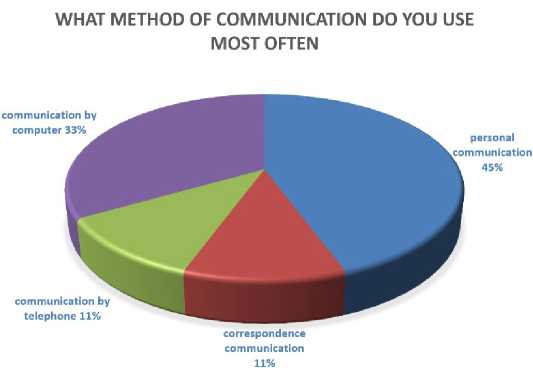
The most common form of communication in the company is personal communication, used by 44.44% of employees. Co-mmunication via computer is represented by 33.3%. The least represented forms of communication are correspondence and telephone with 11.11%. Based on the results obtained, we can
Chart 2: Economic propaganda influences consumer decisions
Economic propaganda influences consumer decisions
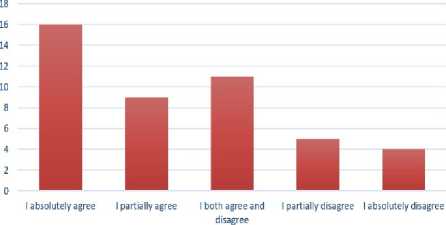
conclude that the company uses personal communication the most in performing its business tasks.
Question number 2: Does economic propaganda influence consumer decisions?
|
Rensponse |
° fl Sh Ф Ф пЗ q |
Ф 5 fl Ф ф co |
|
I absolutely agree |
16 |
35,55 |
|
I partially agree |
9 |
20 |
|
I both agree and disagree |
11 |
24,44 |
|
I partially disagree |
5 |
11,1 |
|
I absolutely disagree |
4 |
8,8 |
|
Total |
45 |
The largest number of respondents, 35.5%, absolutely agree with the above statement, while only 8.8% of respondents expressed absolute disagreement. Of the total number of respondents, 24.4% both agree and disagree with the above statement.
Question number 3. Does commercial propaganda affect consumer brand loyalty?
|
Rensponse |
° fl L Ф Ф пз Sh |
То ф Sh ft Ф CO |
|
I absolutely agree |
14 |
31,1 |
|
I partially agree |
10 |
22,2 |
|
I both agree and disagree |
11 |
24,4 |
|
I partially disagree |
8 |
17,7 |
|
I absolutely disagree |
2 |
4,4 |
|
Total |
45 |
Chart number 3. Economic propaganda affects consumer loyalty towards the brand
Economic propaganda affects consumer loyalty towards brand
I III.
I absolutely agree I partially agree I both agree and I partially disagree I absolutely disagree disagree
The largest number of respondents, 53.3%, absolutely and partially agree with the stated statement, only 4.4% of respondents express absolute disagreement. Of the total number of respondents, 17.7 partially disagree with the given statement.
Question number 4. Which means of transmitting promotional messages has the greatest impact on consu-mer decisions?
|
Response |
50 ° q Ф Ф пЗ Sh |
Ф 2 bl fl fl Ф «fl s-i a ф co |
|
Print medianewspapers-magazines |
7 |
15,5 |
|
On-site sales |
20 |
44,4 |
|
Internet-socal networks |
15 |
33,3 |
|
ТV sales |
3 |
6,6 |
Graph 4: Means of transmitting promotional messages that have the greatest impact on consumer decisions
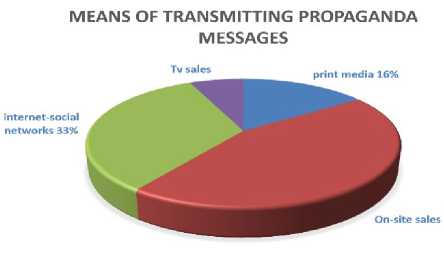
Source: Author's research
Among the respondents, the majority believe that on-site sales have the greatest influence on consumer decisions (44%), followed by social networks (33%), print media (16%), and TV sales (7%). Based on the results obtained, we can conclude that consumers most often make decisions on the spot where they buy a certain product.
Question 5: How does commercial
Conclusion propaganda affect business communication?
|
response |
° Й 4 Ф Ф t5 8 ° Z ф 5ч |
Ф tB ей Й ф Д ^ ТЗ Ф о о Й й ® Рч ^ |
|
positive |
25 |
55,5 |
|
negative |
5 |
11,1 |
|
no influence |
15 |
33,33 |
Graph 5: Opinion about the influence of economic propaganda on business communication
HOW DOES ECONOMIC PROPAGANDA AFFECT BUSINESS COMMUNICATION
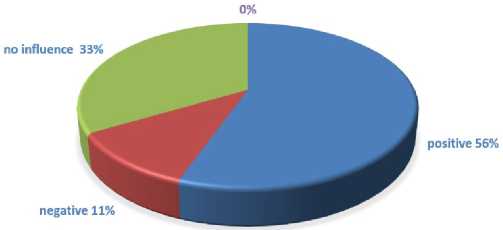
To this question, more than half of the respondents (56%) stated that commercial propaganda has a positive impact on business communication. 11% of respondents believe that propaganda has a negative impact on business communication, and 33% of those surveyed believe that propaganda has no impact on
If there is no good communication, there is no progress, neither on a personal nor a business level. Good and successful communication can increase profits, while bad and incorrect communication can reduce them. That is why there are certain standards and codes of conduct that need to be respected, so that the behavior of employees in the work-place is not left to chance. Good communication skills guarantee better business communication and success. Communication skills should be constantly improved. Economic propaganda is one of the most effective ways of business communication, allowing companies to send their messages to a large number of consumers. Its essence lies in establishing an emotional and rational connection with the target group, using a variety of media and communication channels. Modern forms of propaganda, especially those on digital platforms, make high personalization of messages and direct interaction possible, which significantly improves the experience of communication with business communication.
consumers.
The basic hypothesis: Economic propaganda as a form of business communication significantly influences consumer decisions and preferences, product and manufacturer image, product recognition and differentiation, and market competitiveness has been confirmed as correct.

